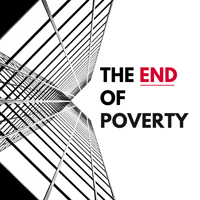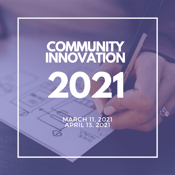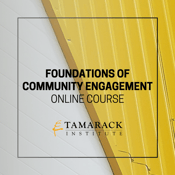Engage in Community Change
Tamarack Institute | February Edition, 2021
Welcome to Engage!
In this edition of Engage! we're excited to present a collection of articles and resources focused on how communities and networks are working to end poverty in Canada and beyond. Read articles about unprecedented poverty reduction happening in communities across Canada, including a case study focused on how Montreal is working at the neighbourhood level to end poverty, these features provide both inspiration and practical lessons learned from the great work that is being done to end poverty across the country.
Feature Articles

Communities Ending Poverty
BY: PAUL BORN
What is the end of poverty? What will it take to end poverty in Canada? If we reduce poverty to 5%, will be able to say that we have effectively ended economic poverty? Could we then target health and well-being to end poverty for all Canadians? At 5% poverty could we afford a Guaranteed Annual Income? What are your questions and ideas about the end of poverty?
On May 5-6, 2021, at Cities Reducing Poverty’s virtual summit – The End of Poverty – more than 500 people will convene to learn about how we can end poverty in our communities. We are at a unique moment in history in which cities, provinces/territories and our federal government are all converging with independent, yet interrelated, poverty reduction strategies. This national event will facilitate learning and dialogue across sectors, harness the distinctive synergies of today's poverty reduction movement, and take our collective understanding of community innovation in poverty reduction to the next level.
Tamarack and the Cities Reducing Poverty network’s primary goal since 2010 was to contribute to poverty being reduced for 1 million people. At that time we considered the goal to be a “moon shot” strategy meant primarily to inspire. However, this goal was realized in March of 2020 (pre-COVID-19). It was then that the Government of Canada officially announced that between 2015 and 2018 (the latest year for which we have comprehensive data), poverty had been reduced to its lowest level in recorded history, from 14.5% to 11.0%, and that 1 million fewer Canadians were living in poverty. Of those lifted out of poverty, 334,000 were children and 73,000 were seniors.
This unprecedented reduction was achieved through a system of exceptional programs and supports of organizations and governments that work at the local, provincial, territorial, and national levels. It has no one cause or attribution, but rather is the result of contributions made by many. Together, we are getting poverty reduction “right” and are establishing a powerful narrative for ending poverty in Canada.
The Cities Reducing Poverty Network has become a significant contributor to poverty reduction in Canada, and we are grateful for our many partners. Our regional members are having real success in reducing poverty in their cities. Between 2015 and 2018, poverty rates decreased in 10 of the 14 CRP regions where 2018-base Market Basket Measure (MBM) data is available. The most notable reductions were seen in Saint John (from 19.5% to 14.0%), Toronto (from 19.2% to 13.9%), and Winnipeg (from 15.5% to 12.0%).
Each of these three CRP members champion poverty reduction both within and beyond their own communities, as they regularly share their experiences, strategies and successes, and provide support to less advanced members of the network. When Saint John joined CRP in 2002, they had nearly 28% of their population living in poverty – one of the highest poverty rates in the country – and their explicit goal was to cut that rate in half. After nearly 20 tireless years, they have achieved their goal.
The Cities Reducing Poverty Network
Founded in 2002, Cities Reducing Poverty (CRP) has grown from 45 regional roundtables in 2015 to 80 in 2020 that now support more than 330 municipalities. CRP is a powerful collective impact movement that is supported and funded through a partnership between the Tamarack Institute, McConnell, Maytree, and the federal government. The learning community that was formed to deeply understand the work of reducing poverty grew from 1,250 changemakers in 2015 to 6,300 in 2020.
CRP is effectively the largest network of its kind in the world. Cities are leading the way! In a recent article, David Brooks of the New York Times shared that Canadian cities are working together in an unprecedented way to develop place-based approaches to ending poverty. He noted how more than 300 cities are developing community plans that engage governments, businesses, not-for-profits, and citizens with lived/living experience of poverty to work together to implement new approaches.
As cities harness the assets of their communities, they are finding new ways to end poverty. Increasingly, they are recognizing poverty as a comprehensive issue, advancing their understanding of collaboration across sectors, and nudging policy and systems change. Cities are recognizing the value of linking private sector and community solutions and are addressing the disproportionate impacts of poverty on black, Indigenous and people of color (BIPOC). They are working directly with local businesses and are meaningfully engaging people with lived/living experience in leadership roles and decision-making opportunities to move their work forward.
Communities are increasingly recognizing the importance of embedding a Collective Impact approach to their work. They are developing common agendas and shared measurement systems between partnering groups, working toward mutually reinforcing activities, and cultivating continuous communication and strong backbone organizations in order to realize high-impact city-wide approaches that achieve powerful outcomes.
Over the last two decades, much has been learned about the collective processes cities undertake to reduce poverty. The End of Poverty will feature impactful approaches that cities are applying to develop community plans, promising practices they are developing to manage large-scale collaborations, and strategies they are implementing to influence large-scale policy shifts and meaningful change for people living on low incomes.
The CRP network of members is engaged in all aspects of poverty reduction – from delivering programs, projects and services, to shifting community awareness and building community will, to realizing large scale systems and policy change. Our members raise collaborative funds, bridge communication between sectors, and build momentum for ending poverty in their communities, across Canada and beyond.
Learn more:
- Register for The End of Poverty
- Download the Cities Reducing Poverty membership brochure
- Learn more about Cities Reducing Poverty at citiesreducingpoverty.ca
- Read David Brooks’ article: Winning the War on Poverty
- Read Cities Reducing Poverty’s 5-year Impact Report
 A Powerful Collective Impact Movement
A Powerful Collective Impact Movement
BY: Alison Homer
Cities Reducing Poverty (CRP) is a powerful collective impact movement that has grown to support more than 330 municipalities represented by 80 regional roundtables. Members adopt collective impact approaches to drive long-term change and develop and implement plans to reduce poverty in their communities. They ensure that all sectors are brought to the table, harness the assets of their communities, and realize powerful outcomes. We have learned that to reduce poverty, it takes the whole community and our entire country working together.
Highlights of our work over the last five years include:
- One Million Fewer People Living in Poverty
CRP’s primary goal since 2010 was to contribute to poverty being reduced for 1 million Canadians. This goal was realized in of March 2020 (pre-COVID-19), when the Government of Canada announced that between 2015 and 2018, poverty had been reduced for more than 1 million Canadians. Our regional members have also demonstrated real success in reducing poverty in their own cities and communities. Between 2015 and 2018, poverty rates decreased in 10 of 14 CRP regions, with the most notable reductions were seen in Saint John (from 19.5% to 14.0%), Toronto (from 19.2% to 13.9%), and Winnipeg (from 15.5% to 12.0%).
- CRP Has Realized Significant Growth:
CRP has developed a critical mass, forming what is essentially the largest network of cities working and learning together in the world. Between 2015 and 2020, CRP nearly doubled in membership, from 45 members and 1,200 changemakers (individuals that learn from our case studies, research, events, webinars, and publications) in 2015, to 80 members and 6,337 changemakers in 2020. Notably, our Western membership has now grown to equal our Eastern membership. In a 2019 article published in the New York Times, acclaimed columnist David Brooks noted that CRP had created a unique approach that was truly working to end poverty.
- Supporting Provinces and Territories
CRP is working with provinces and territories that are making a real difference in reducing poverty. Between 2015 and 2020, eight provinces and territories (SK, NV, PEI, NWT, BC, MB, ON and NB) either developed or renewed their poverty reduction plans. Poverty rates decreased in all ten provinces between 2015 and 2018, with the most significant reductions seen in New Brunswick (6.1%) and British Columbia (5.7%). Recommendations from CRP members in Alberta contributed to 22 policy changes, including the recommendation for a provincial child benefit. CRP also helped to inform the B.C. government’s Poverty Reduction Planning and Action program, which has committed $5 million to local governments, through which all 14 CRP members that applied for its first funding round were successful in their applications.
- Advancing Policy Changes to Reduce Poverty
CRP has actively advanced progressive policy changes with all levels of government. For example, members have met for over a decade to learn about and shape discussions and policies around minimum wage, Living Wage, and Basic Income. Over the last five years, Nunavut increased its minimum wage to $16.00 per hour, Alberta to $15.00, BC to $14.60, and Ontario to $14.25. Two considerable wins for the network were Côte-des-Neiges—Notre-Dame-de-Grâce developing a poverty reduction strategy after attending our 2016 summit, and Hamilton’s mayor announcing the city’s 10-year plan to invest $50 million in poverty reduction at our 2017 summit.
- Supporting Canada to Launch its First Poverty Reduction Strategy
CRP worked directly with Employment and Social development Canada (ESDC) to support 27 CRP members to host 33 community consultations in their cities – the most of any organization in Canada – across 9 provinces and territories that reached more than 600 people. Former Minister of Families, Children and Social Development, Hon. Jean-Yves Duclos, noted that “Tamarack (CRP) has been a key part of the Poverty Reduction Strategy...and were instrumental in providing us with grassroots, on the ground, community level feedback.”
- CRP Accelerated Learning and Grew Impact
CRP, with the direct support of the Tamarack Institute, has become a top resource in Canada for place-based poverty reduction thinking and action. Our work has been recognized by many awards, including an Order of Canada. We were profiled in the Philadelphia Citizen as an idea the U.S. should “steal”. We are particularly proud our work elevating the wisdom and perspectives of people with lived/living experience of poverty. TEN – A Guide for Engaging People with Lived/Living Experience of Poverty, which was developed by an advisory committee of lived/living experience experts, was Tamarack’s top publication of 2019, and is approaching 10,000 downloads.
CRP is proud of what we have accomplished together over the last 5 years. While 2020’s COVID-19 pandemic introduced an unprecedented challenge, the CRP network has responded nimbly with incredible responsiveness and resilience.
Over the next few months, as we build momentum for our 2021 End of Poverty virtual national summit, CRP will be engaging content and context experts in articulating 10 Ending Poverty Pathways.
With more cities joining the CRP network, every year, we are confident that the solid foundation that we have built together for this work, will serve as the critical support we need as we continue to amplify our contribution toward ending poverty in Canada.
Learn More:
- Register for Cities Reducing Poverty’s May 5-6th End of Poverty national gathering
- Read the full Cities Reducing Poverty 5-year impact report
- Visit the Cities Reducing Poverty website and download our membership brochure
- Email Alison to learn more about Cities Reducing Poverty membership
Featured Case Study
 Montreal’s Collective Impact Project: Five Years of Reducing Poverty at the Neighbourhood Level
Montreal’s Collective Impact Project: Five Years of Reducing Poverty at the Neighbourhood Level
BY: Sylvia Cheuy
Montreal’s Collective Impact Project (CIP), which launched in 2015, is an innovative and inspiring example of Collective Impact at the neighbourhood level. The CIP was started to accelerate the impact of collective action and achieve significant outcomes in reducing poverty in Montreal.
By embracing a focus at the neighbourhood scale and a clear long-term goal of reducing poverty, the CIP empowers local neighbourhoods to generate changes that are designed by and for their own community with a focus on some of the many dimensions of poverty:
- food
- housing
- social inclusion
- academic success
- employment
- community infrastructure and facilities
Montreal’s unique approach to Collective Impact intentionally builds upon a rich tradition of and infrastructure for collective action. One of the most significant of these are the 30 Neighbourhood Round Tables that have been in place since the late 1980s and cover most of the city’s older neighbourhoods in the urban core as well as well as some in more suburban neighbourhoods. Each Round Table is its own local cross-sector and multi-network consultation network with its own way of working and its own identity - just like each neighborhood
The impact on poverty being generated by CIP neighbourhoods through the combined efforts of their various strategies is significant. These impacts include both measurable improvements for people living in poverty as well as greater knowledge and understanding about the challenges being faced by those living on low income, as well as promising neighbourhood-based solutions. Some of the impacts generated by the CIP Project in 2019-20 include:
- 7,000 people gaining improved access to healthy affordable food through activities in 8 neighbourhoods
- 1000 acts of support to 120 tenants in 1 neighbourhood which resulted in 66% of them experiencing improvements in their housing conditions; 33% receiving support to move; and 200 families being educated of their rights as tenants
- 83% of participants who attended Soupe Locale, a series of soup dinners designed and hosted to strengthen social capital in one neighbourhood, reported that the dinners made them want to get involved in their neighbourhood
- 500 immigrant families in one neighbourhood benefitted from an effort to support them in better understanding and navigating their children’s school system and 80% of school staff reported seeing an improved parental involvement in their child’s academic success
Montreal’s Collective Impact Project demonstrates the impact of mobilizing multiple funders, diverse sectors, and resident leaders from 17 neighbourhoods in a united, long-term effort to reduce the multifaceted challenges of poverty while leveraging the uniqueness, creativity and priorities of each neighbourhood.
Learn More:
- Read our case study on Montreal's Collective Impact Project
- Register here for the Tamarack English webinar ColIective Impact in Action | Montréal’s Neighbourhood-Based Poverty-Reduction Movement – Feb 23, 21 @ 1:00 pm ET
- Inscrivez-vous ici pour le webinaire Tamarack en français L’impact collectif en action | Le mouvement de réduction de la pauvreté dans les quartiers de Montréal - 25 février 2021, de 13 à 14 h HE
- Learn more about the Collective Impact Project
- Watch this short video produced by one of CIP’s 15 neighborhoods (Centre-Sud) that illustrates how they share about the impact of their work
- Regardez cette courte vidéo produite par l’un des 15 quartiers du CIP (Centre-Sud) qui illustre comment ils partagent l’impact de leur travail
Featured Event and Webinar
 The End of Poverty Virtual Gathering
The End of Poverty Virtual Gathering
Virtual Summit | May 5-6, 2021
The End of Poverty gathering will bring together government, business, community and lived/living experience leaders from across Canada to celebrate our successes and co-generate solutions. This event will feature world renowned speakers like Melody Barnes and Calgary's Mayor Naheed Nenshi, engaging panels and workshops, and daily small group discussions, each serving to help collectively advance ideas for ending poverty. Participants will also have the opportunity to deepen their learning through one of four courses that will be offered at 50% off of Tamarack's regular rate.
Communities Mobilizing to Build Youth Futures
March 3, 2021, featuring Melody Barnes and the Honourable Bardish Chagger

Join Melody Barnes and the Honourable Bardish Chagger, Canada’s Minister of Diversity and Inclusion and Youth, as they discuss how we might approach better futures (including ending poverty) for young people in Canada and beyond. While Melody Barnes was leading the White House Domestic Policy Council under President Barack Obama, the DPC was supporting the work of the White House Council on Community Solutions with honorary chair Michelle Obama and leaders from the private, nonprofit and philanthropic sectors. Two key recommendations of that council were to focus on solutions for Opportunity Youth (youth whose futures had stalled in or after high school) and to ensure that every community was able to access a collective impact approach to community change. To date, more than 1 million youth have improved lives.
Join us to learn how we are using the incredible experiences and ideas Melody Barnes implemented from the White House here in Canada.
 Are you a youth aged 15 to 30 who lives in Canada? Do you like to share your perspectives and vision through photography?
Are you a youth aged 15 to 30 who lives in Canada? Do you like to share your perspectives and vision through photography?
We are looking for original photos that explore the idea of prosperity and a future where young people in Canada thrive.
The Future of Prosperity
How will youth impact the future of prosperity? Will prosperity ensure better youth futures? How might prosperity end youth unemployment and poverty? How might we create a world with stronger connections for youth, opportunities to shrink the income gaps and have fewer “haves and have nots”? We would like you to explore the idea of prosperity through photos.
Why? We believe that we can learn a lot from youth. We believe that youth perspectives, beliefs, and visions for the future should shape our work and we want to share these with changemakers across the country.
- We will be selecting 10 photos to be part of an online gallery. This gallery will be virtually “toured across Canada” in May & June, 2021. If your photo is selected to be part of the online gallery, you will receive $500.
- We will be selecting 20 photos to be featured in our publications and newsletter. If your photo is selected to be published, you will receive $50.
All selected photos will be shown during our virtual conference in May and may be included in our reports and on our social media and web accounts.
Learn more about the photo contest rules and how to submit your photo here
***
 Es-tu un-e jeune âgé-e de 15 à 30 ans vivant au Canada? Aimerais-tu faire connaître tes perspectives et ta vision par l’entremise de la photographie?
Es-tu un-e jeune âgé-e de 15 à 30 ans vivant au Canada? Aimerais-tu faire connaître tes perspectives et ta vision par l’entremise de la photographie?
Nous sommes à la recherche de photos originales qui explorent le concept de prospérité et proposent différentes visions d’un avenir où les jeunes du Canada s’épanouissent.
L’avenir de la prospérité
Comment les jeunes influenceront-ils l’avenir de la prospérité? La prospérité assurera-t-elle un meilleur avenir aux jeunes? Comment la prospérité pourrait-elle mettre un terme au chômage et à la pauvreté chez les jeunes? Comment pourrions-nous créer un monde où les jeunes ont l’occasion de créer des liens plus solides et de réduire les écarts de revenus entre les personnes nanties et démunies? Nous aimerions que vous exploriez le concept de prospérité à l’aide de photos.
Pourquoi? Parce que nous croyons que nous pouvons apprendre beaucoup des jeunes. Nous croyons que les perspectives, les convictions et les visions que les jeunes entretiennent pour l’avenir devraient guider notre travail, et nous voulons les faire connaître aux agent-e-s de changement à travers le pays.
- Nous sélectionnerons dix photos qui seront exposées dans une galerie virtuelle. Cette dernière sera présentée lors d’une « tournée » virtuelle à travers le Canada qui s’étalera de mai à juin 2021. Si votre photo sera sélectionnée pour être exposées dans la galerie virtuelle, vous recevrez un prix de 500 $.
- Nous sélectionnerons 20 photos qui seront présentées dans nos publications et notre bulletin. Si certaines de vos photos sont retenues pour être publiées, vous recevrez 50 $ pour chacune d’elles.
Toutes les photos sélectionnées seront présentées lors de notre conférence virtuelle qui aura lieu en mai. Elles pourraient également être utilisées dans nos rapports, de même que nos comptes sur les médias sociaux et notre site web.
Community Innovation 2021
Virtual Workshop
March 11, 2021 | Register for the March Workshop
April 13, 2021 | Register for the April Workshop
At Tamarack, Community Innovation is considered the most impactful of the 5 practices of community change.
Join Sylvia Cheuy for a new virtual workshop designed to provide you an opportunity to explore key theories, tools, and approaches in the practice of Community Innovation and equip you with the knowledge you need to ensure that innovation is intentionally incorporated into your community change efforts. how the Community Engagement landscape is changing and evolving.
Co-Design: Facilitating Community-Led Innovation
A new 4-part virtual workshop | May 4th, 11th, 18th, and 25, 2021
Join Liz Weaver and Lisa Attygalle for 4-part virtual workshop designed to give you hands-on experience and a step-by-step approach to designing and facilitating collaborative Community Innovation sessions.
We'll go deep on different approaches to engage the community to innovate together, understand what makes these kinds of gatherings distinct, and provide you with tools that you can use to host them.
Foundations of Community Engagement
Online Course | Access course materials anytime and learn at your own pace
Join Tamarack's Lisa Attygalle, Director of Community Engagement to build a foundation of knowledge and practice for your community engagement work.
Through video lessons, case studies, readings, and activities, you'll dig into the role of community, who should be engaged, community engagement techniques, how to overcome challenges, and how to evaluate your engagement activities.
This course is available to use at your own pace, but you'll be learning alongside a diverse group of over 300 Tamarack Institute learners, and have the opportunity to join Lisa for monthly small group coaching to get more personalized feedback and insight.
Making the Case for Arts-Based Community Engagement
Date: February 10, 2021
Speakers: Hiba Abdullah, Christopher Pandolfi and Lisa Attygalle
Innovative Approaches to Ending Social Isolation in Canada
Date: February 17, 2021
Speakers: Lisa Richmond, Sonia Hsiung, Trevor Hancock, and Sylvia Cheuy
Collective Impact in Action Montréal’s Neighbourhood-Based Poverty-Reduction Movement
Date: February 23, 2021
Speakers: Rotem Ayalon, co-coordinator, Collective Impact Project, Centraide du Grand Montréal and Sylvia Cheuy
L’impact collectif en action | Le mouvement de réduction de la pauvreté dans les quartiers de Montréal
Date: February 25, 2021
Intervenant-e-s: Jean-Marie Chapeau, conseiller, Projet impact collectif, Centraide du Grand Montréal, et Nathalie Blanchet, Institut Tamarack



